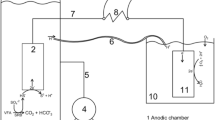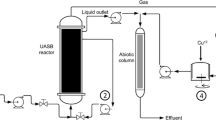Abstract
Anaerobic bacteria and anoxic sediments from soda lakes produced electricity in microbial fuel cells (MFCs). No electricity was generated in the absence of bacterial metabolism. Arsenate respiring bacteria isolated from moderately hypersaline Mono Lake (Bacillus selenitireducens), and salt-saturated Searles Lake, CA (strain SLAS-1) oxidized lactate using arsenate as the electron acceptor. However, these cultures grew equally well without added arsenate using the MFC anode as their electron acceptor, and in the process oxidized lactate more efficiently. The decrease in electricity generation by consumption of added alternative electron acceptors (i.e. arsenate) which competed with the anode for available electrons proved to be a useful indicator of microbial activity and hence life in the fuel cells. Shaken sediment slurries from these two lakes also generated electricity, with or without added lactate. Hydrogen added to sediment slurries was consumed but did not stimulate electricity production. Finally, electricity was generated in statically incubated “intact” sediment cores from these lakes. More power was produced in sediment from Mono Lake than from Searles Lake, however microbial fuel cells could detect low levels of metabolism operating under moderate and extreme conditions of salt stress.







Similar content being viewed by others
Abbreviations
- MFC:
-
Microbial fuel cell
References
Amend JP, Shock EL (2001) Energetics of overall metabolic reactions of thermophilic and hyperthermophilic Archaea and Bacteria. FEMS Microbiol Rev 25:175–243
Bond DR, Lovley DR (2002) Reduction of Fe(III) oxide by methanogens in the presence and absence of extracellular quinones. Environ Microbiol 4:115–124
Chaudhuri SK, Lovley DR (2003) Electricity generation by direct oxidation of glucose in mediatorless microbial fuel cells. Nat Biotechnol 21:1229–1232
Cline JD (1969) Spectrophotometric determination of hydrogen sulfide in natural water. Limnol Oceanogr 14:454–458
Fossing H, Jørgensen B (1989) Measurement of bacterial sulfate reduction in sediments: evaluation of a single step chromium reduction method. Biogeochemistry 8:205–222
Hobbie JE, Daley RL, Jaspar S (1977) Use of nucleopore filters for counting bacteria for fluorescence microscopy. Appl Environ Microbiol 33:1225–1228
Hoeft SE, Kulp TR, Stolz JF, Hollibaugh JT, Oremland RS (2004) Dissimilatory arsenate reduction with sulfide as electron donor: experiments with Mono Lake water and isolation of strain MLMS-1, a chemoautotrophic arsenate respirer. Appl Environ Microbiol 70:2741–2747
Hoeft SE, Switzer Blum J, Stolz JF, Tabita FR, Witte B, King GM, Santini JM, Oremland RS (2007) Alkalilimnicola erlichii sp. nov., a novel, arsenite-oxidizing haloalkaliphilic gammaproteobacterium capable of chemoautotrophic or heterotrophic growth with nitrate or oxygen as the electron acceptor. Int J Syst Evol Microbiol 57:504–512
Jong BC, Kim BH, Chang IS, Liew PWY, Choo YF, Kang GS (2006) Enrichment, performance, and microbial diversity of a thermophilic mediatorless microbial fuel cell. Environ Sci Technol 40:6449–6454
Kim HJ, Park HS, Hyun MS, Chang IS, Kim M, Kim BH (2002) A mediator-less microbial fuel cell using a metal reducing bacterium, Shewanella putrefaciens. Enzyme Microb Technol 30:145–152
Kulp TR, Hoeft SE, Miller LG, Saltikov C, Murphy JN, Han S, Lanoil B, Oremland RS (2006) Dissimilatory arsenate and sulfate reduction in sediments of two hypersaline, arsenic-rich soda lakes: Mono and Searles Lakes, California. Appl Environ Microbiol 72:6514–6526
Kulp TR, Han S, Saltikov C, Lanoil BD, Zargar K, Oremland RS (2007) Effects of imposed salinity gradients on dissimilatory arsenate reduction, sulfate reduction and other microbial processes in sediments from two California soda lakes. Appl Environ Microbiol 73:5130–5137
Logan BE, Murano C, Scott K, Gray ND, Head IM (2005) Electricity generation from cysteine in a microbial fuel cell. Water Res 39:942–952
Logan BE, Regan JM (2006a) Electricity-producing bacterial communities in microbial fuel cells. Trends Microbiol 14:512–518
Logan BE, Regan JM (2006b) Microbial fuel cells—challenges and applications. Environ Sci Technol 40:5172–5180
Lovley DR (2006) Microbial fuel cells: novel microbial physiologies and engineering approaches. Curr Opin Biotechnol 17:327–332
Lovley DR, Goodwin S (1988) Hydrogen concentration as an indicator of the predominant terminal electron-accepting reactions in aquatic sediments. Geochim Cosmochim Acta 52:2993–3003
Miller LG, Jellison R, Oremland RS, Culbertson CW (1993) Meromixis in hypersaline Mono Lake, California. 3. Biogeochemical response to stratification and overturn. Limnol Oceanogr 38:1040–1051
Nisbet EG, Sleep NH (2001) The habitat and nature of early life. Nature 409:1083–1091
Oremland RS (1983) Hydrogen metabolism by decomposing cyanobacterial aggregates in Big Soda Lake, Nevada. Appl Environ Microbiol 45:1519–1525
Oremland RS, Miller LG (1993) Biogeochemistry of natural gases in three alkaline, permanently stratified (meromictic) lakes. In: Howell DG (ed) The future of energy gases, USGS prof paper 1570, pp 439–452
Oremland RS, Kulp TR, Switzer Blum J, Hoeft SE, Miller LG, Stolz JF (2005) A microbial arsenic cycle in a salt-saturated, extreme environment. Science 308:1305–1308
Oremland RS, Dowdle PR, Hoeft S, Sharp JO, Schaefer JK, Miller LG, Switzer Blum J, Smith RL, Bloom NS, Wallschlaeger D (2000) Bacterial dissimilatory reduction of arsenate and sulfate in meromictic Mono Lake, California. Geochim Cosmochim Acta 64:3073–3084
Oren A (1999) Bioenergetic aspects of halophilism. Microbiol Mol Biol Rev 63:334–348
Park DH, Zeikus JG (2000) Electricity generation in microbial fuel cells using neutral red as an electronophore. App Environ Microbiol 66:1292–1297
Rabaey K, Boon N, Siciliano SD, Verhaege M, Verstraete W (2004) Biofuel cells select for microbial consortia that self-mediate electron transfer. Appl Environ Microbiol 70:5373–5382
Rabaey K, Verstraete W (2005) Microbial fuel cells: novel biotechnology for energy generation. Trends Biotechnol 23:291–298
Reed WE (1977) Biogeochemistry of Mono Lake, California. Geochim Cosmochim Acta 41:1231–1245
Reimers CE, Tender LM, Fertig S, Wang W (2001) Harvesting energy from the marine sediment–water interface. Environ Sci Technol 35:192–195
Switzer Blum J, Burns Bindi A, Buzzelli J, Stolz JF, Oremland RS (1998) Bacillus arsenicoselenatis, sp. nov., and Bacillus selenitireducens, sp. nov.: two haloalkaliphiles from Mono Lake, California that respire oxyanions of selenium and arsenic. Arch Microbiol 171:19–30
Thauer RK, Jungermann K, Decker K (1977) Energy conservation in chemotrophic anaerobic bacteria. Bacteriol Rev 41:100–180
Thrash JC, Van Trump JI, Weber KA, Miller E, Achenbach LA, Coates JD (2007) Electrochemical stimulation of microbial perchlorate reduction. Environ Sci Technol 41:1740–1746
Widdle F, Kohring G-W, Mayer F (1983) Studies on the dissimilatory sulfate-reducing bacteria that decompose fatty acids. 3. Characterization of the filamentous gliding Desulfonema limicola, gen. nov., sp. nov., and Desulfonema magnum, sp. nov. Arch Microbiol 134:286–294
Wrighton KC, Agbo P, Warnecke F, Weber KA, Brodie EL, DeSantis TZ, Hugenholtz GL, Anderson GL, Coates JD (2008) A novel ecological role of the firmicutes identified in thermophilic microbial fuel cells. ISME J. doi:10.1038/ismej.2008.48
Acknowledgments
We thank Suresh Seshadri and Martin Buehler of JPL for their enthusiastic support of this project. The following people helped in the laboratory: Jodi Switzer Blum, Stacy Bennett, Shelley Hoeft, Tom Kulp, Shaun Baesman, John Duff, and Larisa Yunerman. Thank you also to Charlie Ogle, Kelly Wrighton, and Cameron Thrash for assistance with microbial fuel cells. Kelly Wrighton and Chad Saltikov reviewed an early draft of this manuscript. Financial support was provided by USGS National Research Program, and NASA ASTID 2003.
Author information
Authors and Affiliations
Corresponding author
Additional information
Communicated by T. Matsunaga.
Rights and permissions
About this article
Cite this article
Miller, L.G., Oremland, R.S. Electricity generation by anaerobic bacteria and anoxic sediments from hypersaline soda lakes. Extremophiles 12, 837–848 (2008). https://doi.org/10.1007/s00792-008-0191-5
Received:
Accepted:
Published:
Issue Date:
DOI: https://doi.org/10.1007/s00792-008-0191-5




